With a $2 billion valuation in a compliant prediction market, how does Kalshi monetize your predictions?
Written by: Thejaswini M A
Compiled by: Luffy, Foresight News
You've been following the Fed meeting for months, knowing they're about to adjust interest rates. Economic data is a loud harbinger, inflation numbers are backing it up, and even subtle changes in Powell's wording hint at the arrival of this moment.
But how do you translate that judgment into trading?
Of course, you can buy bonds and expect them to rise when interest rates fall; Or short the dollar, praying that the correlation remains the same; Or take a heavy position in interest rate-sensitive technology stocks, hoping that the market will interpret the news as you expect.
But if ...... Can you trade directly on the Fed's decisions? What if you didn't play these indirect "derivative games" and just bet on "Will the Fed cut interest rates at the next meeting?" and make $1 per contract if you guessed correctly?
Let's talk about sports betting. You can buy New Balance stock and expect Coco Gauff to win the Australian Open to boost sportswear sales; can short Nike because the players they sponsor are out early; You can also invest in DraftKings, where higher tennis ratings will lead to increased betting volume. But if ...... You can bet directly on whether Gauff will win the Australian Open. Invest $100, get $200 if you guess correctly, and you don't need to look at the company's financial report analysis.
You can buy shares of TKO Group in the hope that WrestleMania will attract a record audience; can short the shares of rival entertainment companies; Or bet on the surge in peripheral sales. But if ...... Can you trade Roman Reigns directly to keep the title? Bet your money directly on the plot ending and skip the analysis of all media companies.
That's exactly what Kalshi lets you do.
Kalshi is the first prediction market regulated by the U.S. Commodity Futures Trading Commission (CFTC), where you can directly trade the results of real-world events – not stocks affected by the event, not currencies that can fluctuate due to news, but the events themselves.
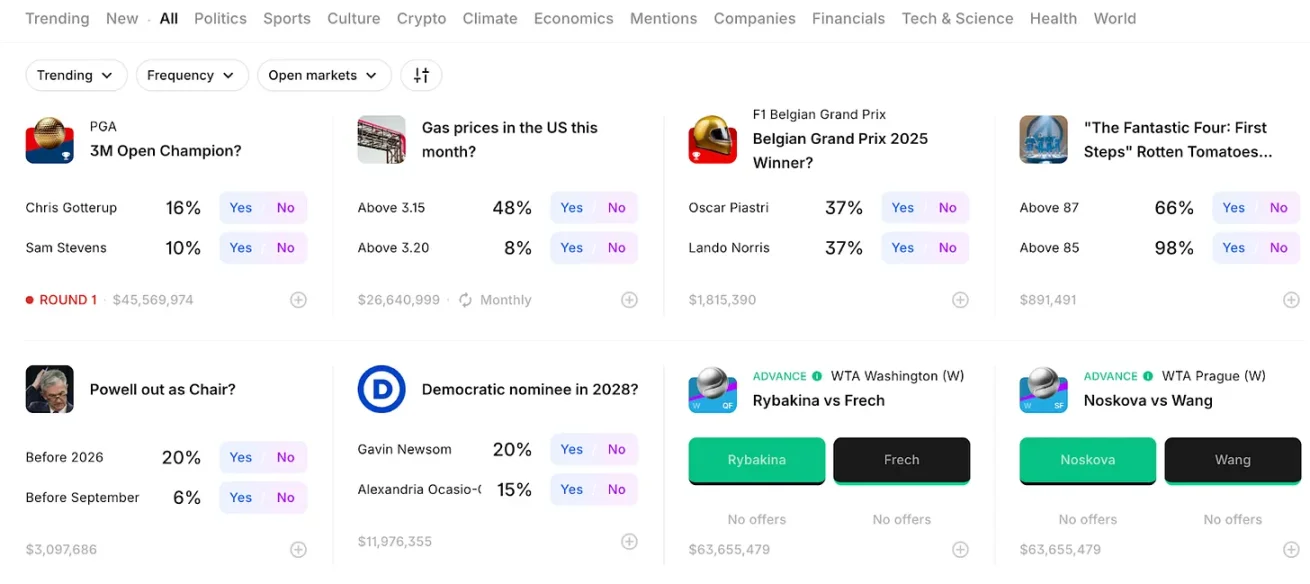
Make your predictions count
Fed decisions, election results, Supreme Court rulings, whether Bitcoin can go to $150,000, whether inflation will exceed 4%, whether the team you support can win the championship...... As long as you can form an opinion and the results are objectively measured, there may be a corresponding market on Kalshi.
Polymarket pioneered the concept of modern prediction markets, handling billions of dollars in trading volume in the US election, proving the immense demand in the market. While Kalshi has just raised $185 million at a valuation of $2 billion, with large trading firms like Susquehanna providing liquidity, and Robinhood integrating the Kalshi market directly into its platform, allowing millions of retail traders to participate. Elon Musk's Grok AI is even embedded in its trading interface.
This is a regulated, institutional-grade "trading reality" infrastructure. Building on Polymarket's global presence, Kalshi brings prediction markets to the regulated U.S. financial system.
Think about what this means: for the first time, you can directly monetize the advantage of predicting real events without the friction of traditional financial markets – no complex derivatives, no counterparty risk, and no worry about whether your hedging tools will actually work when the event occurs.
If you think the next NFP report will be unexpected, there is a corresponding market; If you believe Trump will win the 2028 election, you can trade the contract now; If you are convinced that AI companies will dominate the next decade, you can bet on specific milestones and regulatory outcomes that will determine their fate.
The platform transforms every non-public piece of information, every analytical advantage, and every well-founded prediction into a potential profit opportunity. Unlike traditional markets that leverage information through complex strategies, prediction markets directly reward knowledge.
How Kalshi works
Understanding Kalshi's mechanics is crucial, as event contracts operate differently than any financial instrument you've traded. Let me use a real example to take you step by step.
Step 1: Account setup and recharge
Create an account on kalshi.com and complete the necessary identity verification (KYC). Since Kalshi is regulated by the CFTC, you will need to provide standard documents such as ID and proof of address.
In terms of recharge, Kalshi offers a variety of options with different limits and arrival speeds: bank transfers are free, but it takes 1-2 business days; Debit cards are credited instantly but with a 2% fee and a daily limit of $2500; Cryptocurrency users can deposit USDC with a daily limit of $500,000 and receive it within 30 minutes. Wire transfers are suitable for large amounts of money but have minimum requirements.
Step 2: Understand market pricing
Go to any of the markets and see the current pricing structure. Take the "Will Bitcoin Rise to $150,000 by 2026" market as an example: the current "yes" contract is quoted at 44 cents and the "no" contract is 59 cents, which means that the market believes that the probability of Bitcoin rising to $150,000 by 2026 is 44%.
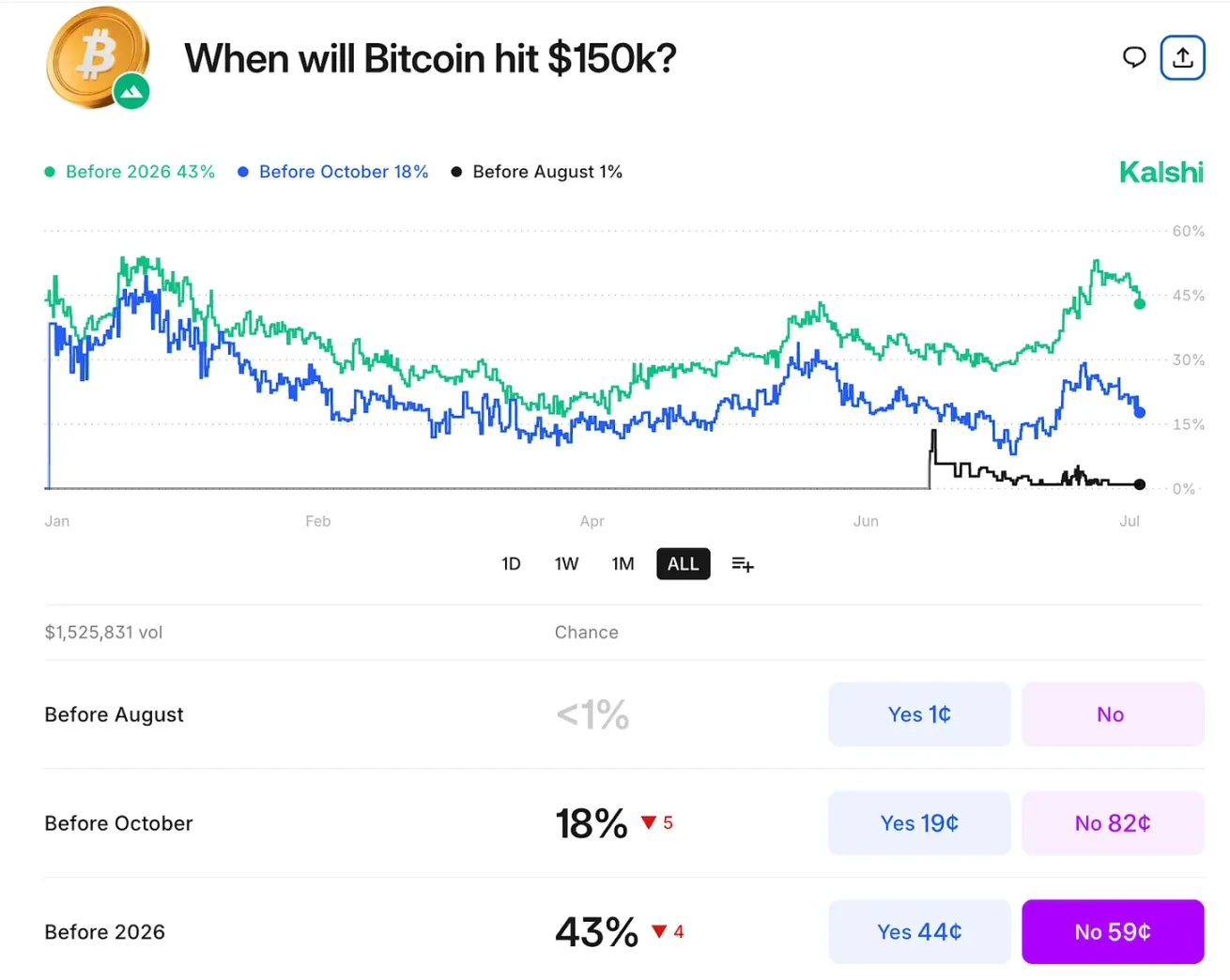
The interface will clearly show your potential profit: if you buy a "yes" contract at 44 cents, Bitcoin really rises to $150,000, and you get $1 per contract, making a profit of 56 cents each. If it does not rise, the contract will be invalid at the expiration date.
Here's how it works: let's say you think Bitcoin can go up to $150,000 and want to buy 100 "yes" contracts at 44 cents each, paying a total of $44. If Bitcoin reaches the target by 2026 and pays $1 per contract, you will get a total of $100 and make a profit of $56; If the target is not met, the contract will be voided and you will lose $44.
Step 3: Place an order
Choose to buy "Yes" or "No" contracts, enter the amount (minimum 1 USD), and the platform will automatically calculate how many contracts you can buy and the maximum profit.
Or the example of Bitcoin: buying a $1 "yes" contract for 44 cents would buy about 2.27 shares. If you guess correctly, you get $2.27 and make a profit of $1.27. The calculation process is transparent until the transaction is confirmed.
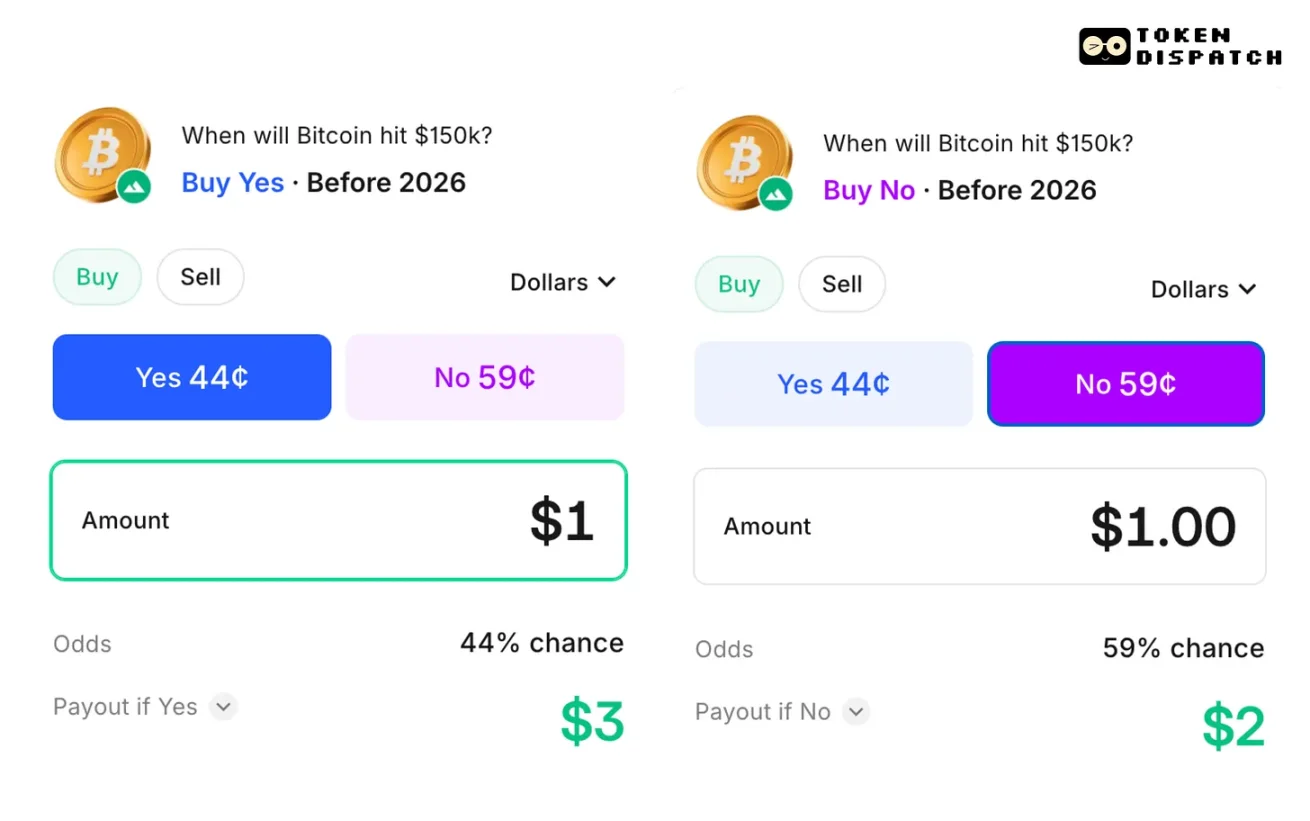
The subtlety of this model lies in its simplicity: your biggest loss is the buying cost, the maximum gain is $1 per share minus the bid price, no margin calls, no complex Greek letters, and no overnight financing costs.
Step 4: Multiple time frames
Many markets offer contracts with different time frames for the same event. The market for Bitcoin $150,000 will be "before August" (current probability < 1%)、「10 月前」(18% 概率)、「2026 年前」(43% 概率)等选项。
Each timeframe is a separate trade. If you think Bitcoin won't reach $150,000 until next year, you can buy a "yes" contract expiring in 2026 and sell a "yes" contract expiring in August.
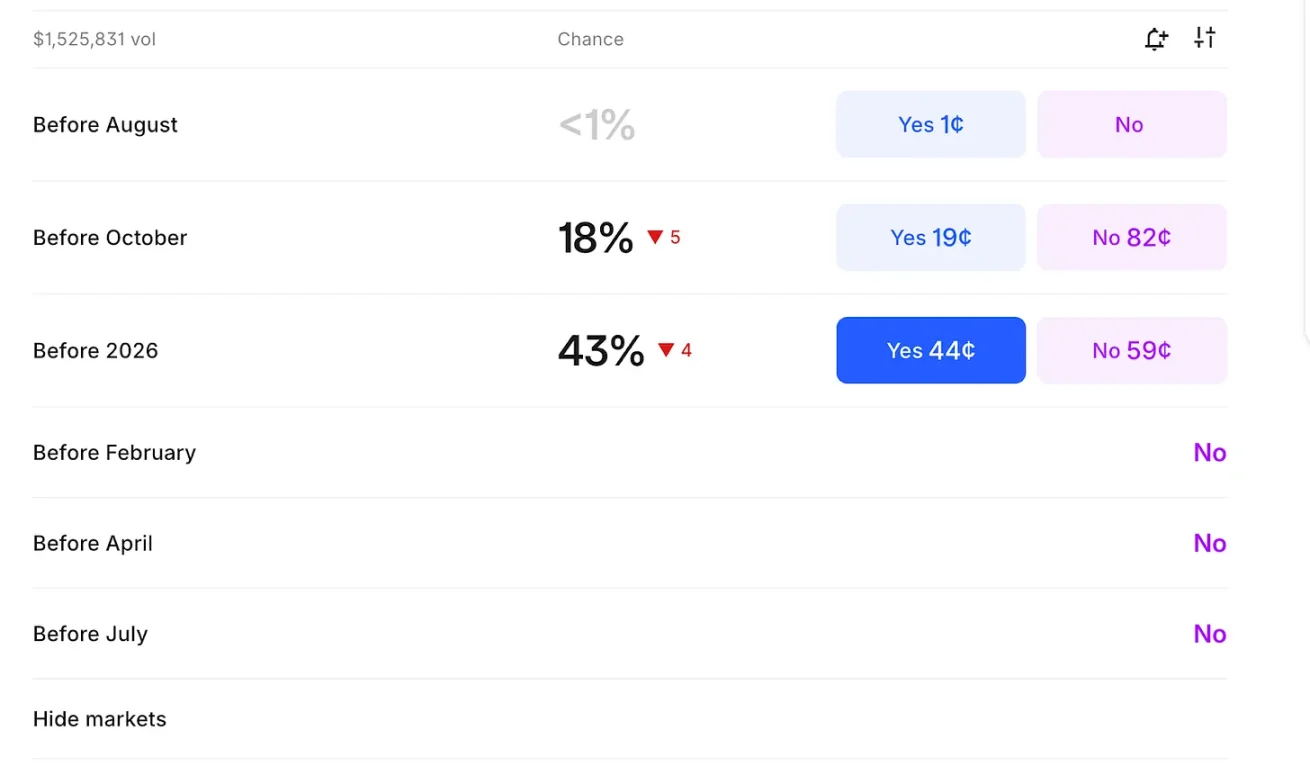
Step 5: Monitor and close your position
You don't have to hold the expiration date, the contract price changes in real time with news and market sentiment. The platform displays real-time price charts, allowing you to track probability changes.
If breaking major news affects your position, you can sell immediately. For example, if you buy a Bitcoin "yes" contract at 44 cents, and the good news pushes the price up to 60 cents, you can sell it immediately and earn 16 cents per share without waiting for the final result.
Closing a position is smooth: you can place a market order (immediately trade at the current price) or a limit order (wait for the target price) and the potential profit or loss will be displayed before confirming the trade. Settlement is done automatically through preset data sources – no disputes, no room for interpretation, just the data.
Position limits prevent a single trader from manipulating the market. Most retail investors can trade up to $25,000 per contract, while institutional traders enjoy higher limits. Fees are charged at 0.7%-3.5% of the contract value, depending on market probability, with contracts with close to 50/50 odds costing more than extreme underdog contracts.
Market Classification and Discovery
Kalshi divides the market into categories: politics, sports, economics, cryptocurrency, climate, etc. Popular sectors highlight markets with high activity or recent price fluctuations.
The platform also has an "Opinions" section, where users discuss market analysis and share trading logic. This community attribute helps you discover new markets and understand different views on event probability.
For active traders, Kalshi provides an API interface that supports algorithmic trading and data analysis: you can access historical price data, place orders automatically, and integrate the Kalshi market into a wider range of trading strategies.
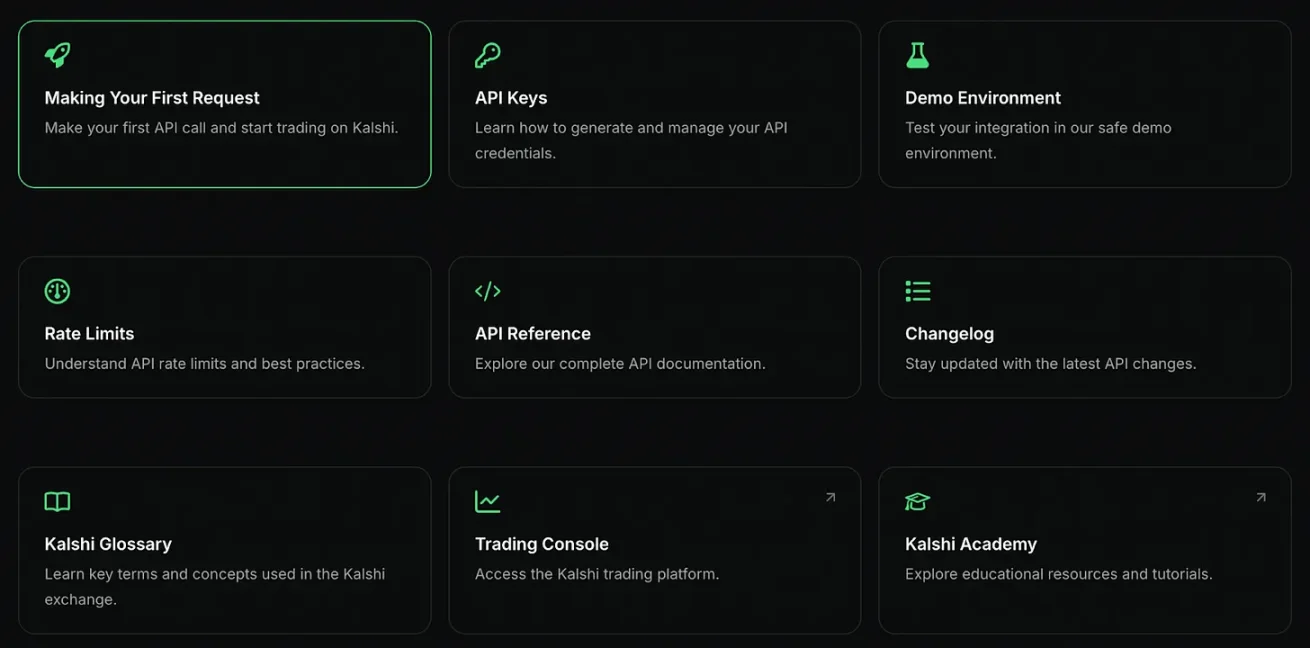
The platform also provides detailed trading volume and open interest data for each contract, helping you assess liquidity before making large trades.
The subtlety lies in its simplicity: no complex derivatives, no leverage, counterparty risk is limited to the exchange itself, only a pure information market, transparent and regulated settlements.
Investment managers use Kalshi to hedge against specific event risks that are difficult to cover efficiently with traditional tools: clean energy funds are concerned about regulatory changes and can directly trade policy outcome contracts for hedging; Portfolios with heavy positions in technology stocks can hedge against antitrust action risks by trading relevant legal markets.
If you hold $1 million in assets, certain policy changes may shrink by 20%, spend $50,000 to buy a 25% probability hedge contract, and if an event occurs, you can get $200,000, just to offset the portfolio loss.
Traders with expertise can monetize their expertise directly: political insiders trade election markets, economic analysts trade Fed decision contracts, and industry experts trade regulatory results markets. Unlike the stock market – where information advantage is quickly arbitraged through complex derivatives strategies – the event market allows excellent predictions to be directly converted into profits. You predict the advantages of FDA approval or Supreme Court ruling, which can immediately turn into a transaction profit.
Grok integration
The recent partnership with xAI offers a glimpse into the future of information trading.
Grok's integration provides real-time analysis of on-chain data, historical odds, and breaking news within the Kalshi interface. Before placing an order, users can query Grok for event background, probability assessment, and related data trends.
This creates a feedback loop: AI helps traders make better predictions, predicting market outcomes and training the AI system's ability to predict reality. Grok is tested in real-time probability assessments, and traders receive AI-enhanced information analysis.
Its impact extends beyond individual trading decisions: as AI systems become better at processing vast amounts of information and identifying probabilistic patterns, predicting markets becomes more efficient. This means tighter spreads, more accurate price discovery, and more practical hedging applications.
Kalshi vs. Polymarket
The prediction market space now has two leaders with complementary ideas: Polymarket pioneered the prediction market industry with crypto-native innovations, and Kalshi was born for Wall Street.
Core differences
Kalshi is fully regulated by the CFTC, funds are in federally insured accounts, disputes are resolved through a clear process, and everything works in line with traditional finance: topping up with bank transfers, trading in US dollars, and withdrawing to checking accounts.
Polymarket has proven the global viability of the model by settling disputes with USDC and resolving disputes through decentralized oracles, and has recently received the appropriate license in the United States to expand into regulated markets.
Audience differences
Institutional funds flow to Kalshi as regulation brings certainty: large market makers like Susquehanna provide liquidity, and more than $1 billion in monthly trading volume proves that the mainstream market favors compliant platforms.
Polymarket's innovation and global reach attract both crypto-native users and international traders who value decentralization and permissionless access. Its early success validated the value of the entire prediction market category.
conclusion
For US users who value regulatory protection and traditional financial integration, Kalshi has obvious advantages; The latter is of unique value to global users who adapt to the crypto infrastructure and recognize Polymarket's innovations. The two platforms are driving prediction markets mainstream from different perspectives, and the shared growth reflects the demand for this new asset class from institutional and retail investors.
What it means for your strategy
Whether you're managing a portfolio, building a trading strategy, or just looking to stay updated on financial trends, Kalshi's rise is something to watch.
For portfolio managers: Event contracts provide precise hedging tools to cover risks that are difficult for traditional tools to handle: political risk, regulatory risk, macro event risk can now be directly hedged without relying on imperfect correlations.
-
For active traders: The advantage of information about predicting real-life events can be directly realized, and your expertise in a specific area has a clear path to profit.
-
For long-term investors: Understanding the evolution of predicted markets can help you grasp the "financialization of all measurable uncertainties". Early companies that build this type of infrastructure can reap great rewards.
-
Regulated prediction markets are like DeFi in 2019: they are still in their infancy, but the product-market fit is clear and has great potential for growth as infrastructure improves and adoption increases.
Kalshi's $2 billion valuation and growing institutional adoption suggest that we are past the experimental phase, and that event contracts are becoming a legitimate asset class, with traders who adapt quickly to gain a first-mover advantage in this rapidly expanding market.
Kalshi is the infrastructure layer of "transaction reality", and as the boundaries between information and markets continue to blur, the value of this infrastructure will become increasingly prominent.
